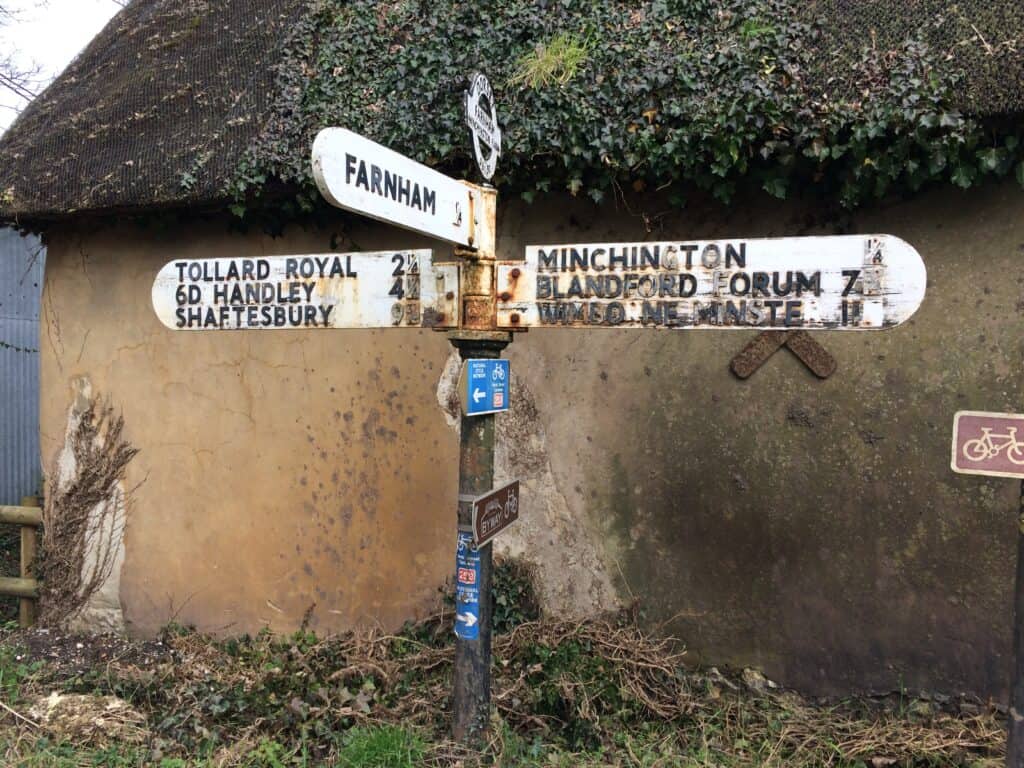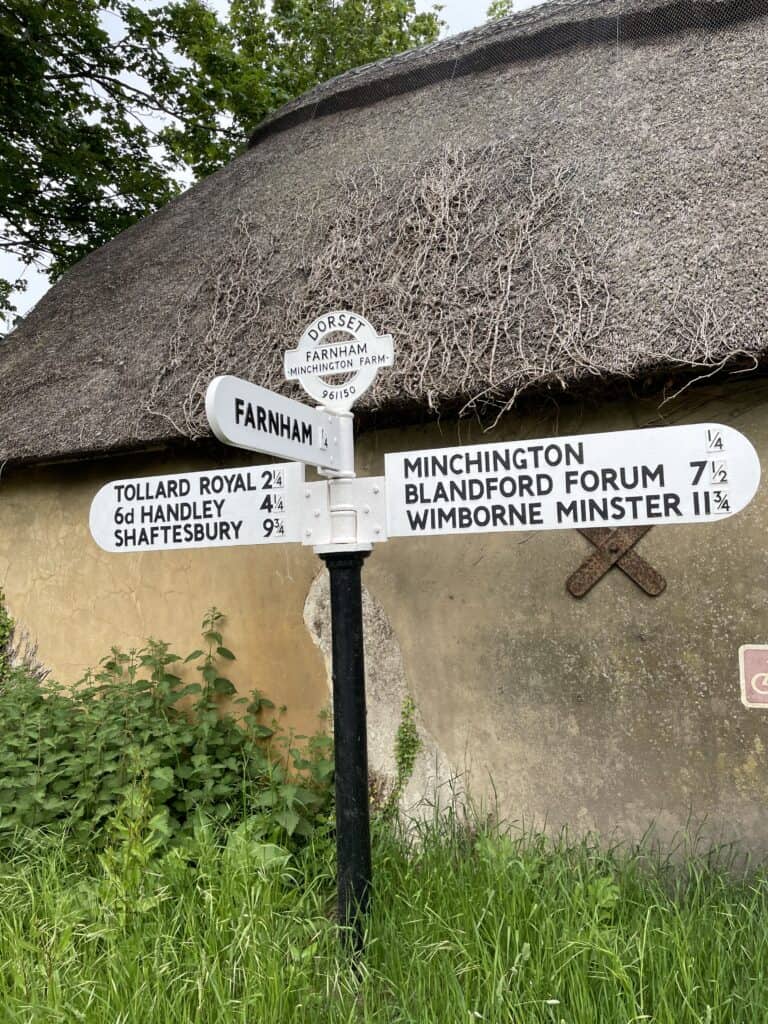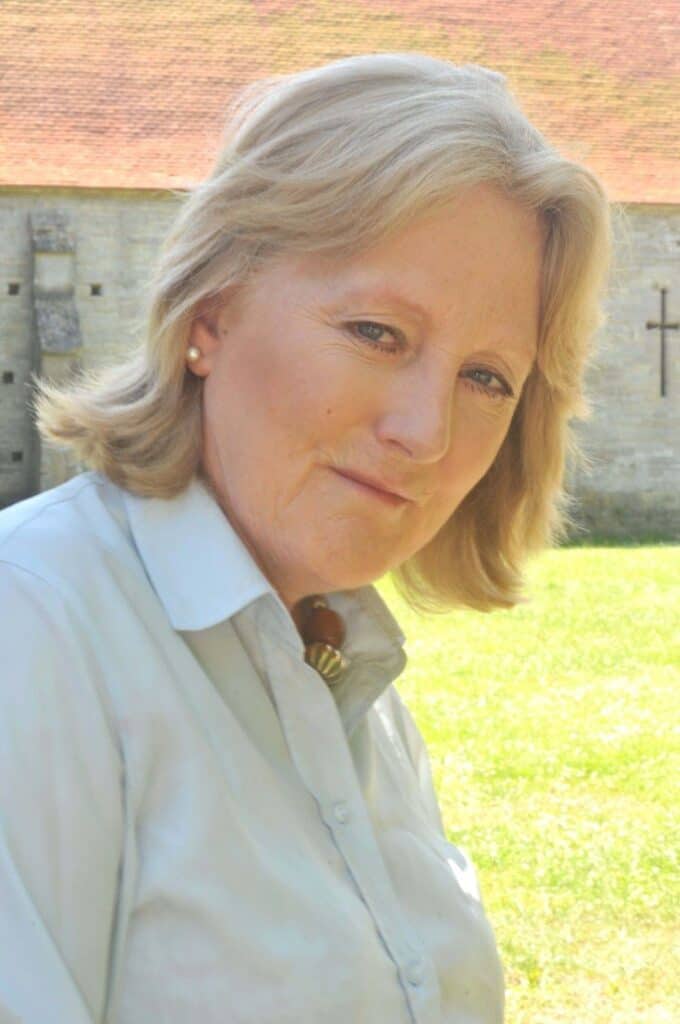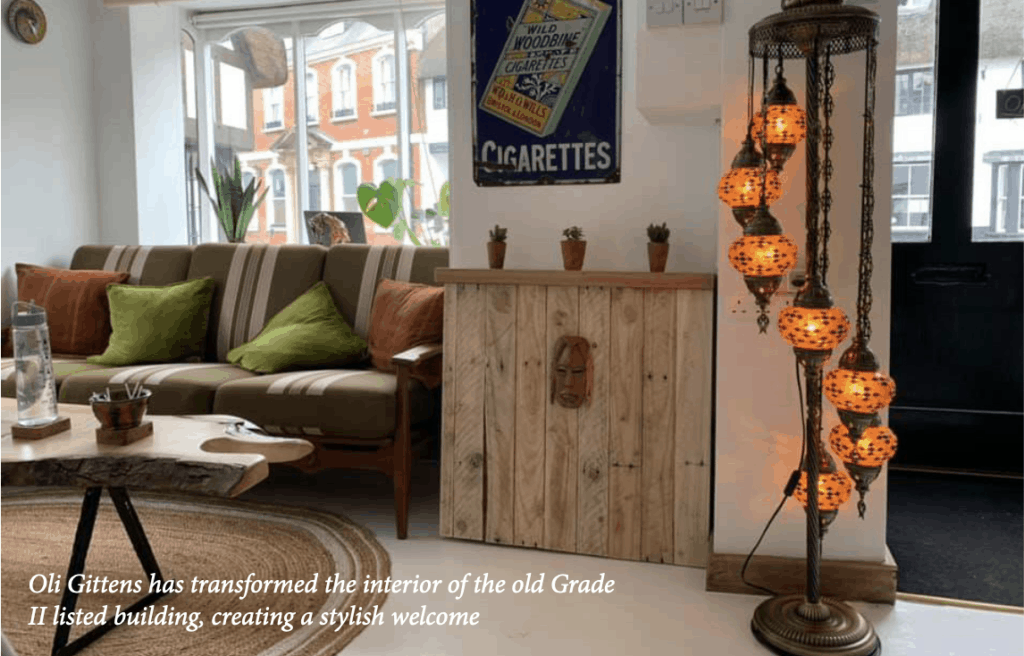Plumber Manor Sturminster Newton
Bar Staff Required
Minimum 3 shifts per week (inc weekends). Some experience helpful, driver essential. (Please send your CV)

Bar Staff Required
Minimum 3 shifts per week (inc weekends). Some experience helpful, driver essential. (Please send your CV)

Jan Rutter – Memorial
Jan passed in February 2021
A memorial will be held on Saturday, 14th August at 2.30pm at the Quaker Meeting House, Abbey Walk, Shaftesbury.
All are welcome.
Please contact – [email protected] if you hope to attend.
Dorset’s fingerposts are an iconic sight; the old road signs featuring a white or occasionally red metal roundel, with arms, known as fingers, pointing in the direction of travel.
They are a common feature of the Dorset countryside, a legacy of the early road system. In 1773 the General Turnpike Act made it mandatory for trustees to put up signs informing the traveller of the distance to the closest town.

In the 20th century the responsibility for fingerposts was given to individual local authorities; the Ministry of Transport recommended a design but it was left up to individual councils to make the final decision, which meant that there was a wide variety of local styles. The Ministry for Transport specifically asked the County Councils in Dorset and the West Riding of Yorkshire to experiment with the inclusion of a grid reference and this style of fingerpost roundel remains unique to these two council areas.
Dorset Council created its own distinctive finger post design; constructed with a central metal post, with a number of white wooden pointers or fingers, originally with curved ends but more recent ones may have pointed fingers.
The destination on the sign is in black, individual, upper case metal lettering, together with the mileage.
On the top is the white metal roundel (just like the London Underground sign), on which the name of the junction is displayed on the horizontal bar. The six figure grid reference is on the bottom half of the roundel, ‘Dorset’ is painted in black, on the top half.
Some of the posts have interesting spellings as well – Sixpenny Handley often shows a frugal use of letters pre-decimalisation with ‘6D Handley’. Fingerposts near Child Okeford still retain the ‘e’ on Child, which has since been lost.

Dorset is also famous for its four red fingerposts – though they are a source of some debate. Were they the locations of gibbets?
The Red Post fingerpost on the A31 was more likely painted red to help prison guards find the local lock-up at the nearby Botany Bay Farm, when accompanying prisoners marching from the Dorchester assizes to the ships at Portsmouth which would convey them to Australia.
Of the 1300 or so fingerposts thought to exist in the 1950s, less than half survive today. Many were lost in WWII; removed in 1940 to deny guidance to an invading army, and never replaced.
Some of the originals have been repaired using non-traditional materials or lettering, and others are in need of attention.
Now the Local Authority no longer has a remit to repair them, both the Dorset Area of Outstanding Natural Beauty (AONB) and Dorset CPRE are keen to support local ‘Fingerpost Champions’ to save these signs from extinction and restore them back to their former glory.
Hundreds of signs are now being renewed by community groups, and individuals.
Roger Bond (Normtec) co-ordinates the Dorset AONB Fingerpost restoration project, working from his home workshop. Normtec are restoring existing lettering and numbers to their former glory whilst Coles Casings provide new stock ready for painting.

If cost is an issue then Dorset AONB are delighted to offer the services of the Dorchester and Blandford Mens’ Sheds, and at HMP Guys Marsh and Youth Offenders Institute on Portland.
Dorset CPRE offer a small grants scheme for people wanting to restore fingerposts using the correct materials as set out by the Dorset AONB.
Match funding is not required, and there is no application form; the CPRE simply ask that requests come from a Parish Council representative (or similar), with a summary of the fingerposts that need repairing, their location(s) and details of who the cheque needs to be made payable to, or bank accounts details for online payments.
Dorset CPRE are covering all of Dorset, and are prepared to award up to £200 per post.
We have now spent or allocated £15,000 on grants for 119 fingerposts with many in North Dorset.
These include Melbury Abbas, East Stour, Farnham and Motcombe to name a few.
To find out more contact Linda Williams on [email protected] or 0333 577 0360.
It is so important that we preserve these Dorset icons!
Rupert Hardy, Chairman,
North Dorset CPRE
In the 80s Harriet Sandys was commissioned by Pinewood Studios to source Afghan costumes for the James Bond film ‘The Living Daylights’.
In the spring of 1989 while visiting Pakistan’s northwest frontier, Harriet discovered several families of traditional silk weavers living in a refugee camp. Harriet obtained funding from the Swedish Government to buy the weavers handlooms, dyes and silk yarn, and the men began to weave silk shawls which were sold through Save The Children.

In the 90s, Harriet was asked by UNESCO to organise and run a training programme in ikat silk weaving and natural dyes in the northern Afghan city of Mazar-I-Sharif.
Harriet now works from a beautifully restored 17th century cider barn selling oriental products which she imports directly. And her past is as colourful as the goods she displays.
As a young woman Harriet Sandys faced danger daily. She could not have worked in a more forbidding part of the world.
This petite woman operated on the North West Frontier – near the Khyber Pass which separates Afghanistan and Pakistan – when the Afghanistans were resisting the Soviet Union invasion which surprised the world on Boxing Day 1979.
Aged 18, she worked with Afghan refugees fleeing the brutality of the Soviets and the endless bombing in the war zone.
‘It was tense,’ she admits with charming understatement. ‘But the Afghans are wonderfully hospitable and I was under the protection of the warlords, who were funded by the West. They knew I was there to help their people and they showed their appreciation.‘

One of the warlords was a certain Osama Bin Laden who then was not radicalised.
Harriet now runs a successful business from a beautifully restored 17th century cider barn in West Compton near Shepton Mallet, importing high quality fabrics, clothing and carpets from the Middle and Far East using contacts gained during her humanitarian work in the 1980s.
Sandys Oriental Carpets is now back in business after 18 months closure due to lockdown.
‘It’s more difficult to import goods, but everything we sell benefits good people in that part of the world, particularly women and girls, who produce incredibly well-made products using silk, Indian cotton and their astonishingly high quality wool. Because I buy direct, I can offer high quality produce at affordable prices.
‘We read a lot of bad things about the area,’ says Harriet, ‘but the real people are lovely, kind and welcoming. It was only when fighters came in from north Africa and Saudi that the radicalisation started.’
After visiting Afghanistan’s capital Kabul many times, Soviet forces closed the airport so she resorted to flying direct to Islamabad, the Pakistan capital where she met the Aga Khan, the revered Islamic spiritual leader.
‘He wanted to see the silk weaving workshops we were introducing, under the aegis of UNESCO, to encourage Afghans to return to their own country when the Soviets pulled out in 1989.’
Harriet learned the local language, Dari, to encourage females to start their own businesses and gain a degree of confidence and financial independence. She also worked with Save The Children.

The locals couldn’t pronounce her name so she became popularly known as Arriot Jan (Jan meaning ‘dear’ or ‘lovely’).
Harriet left school at 16 with no qualifications. ‘I knew I didn’t want to work 9-5 as a secretary.’
Following a sheltered childhood in the Lake District, her parents hoped that after ‘doing the Season’, she would meet and marry a suitable young man. Instead, she learned how to restore oriental carpets, and travelled alone to Pakistan.
‘When I first came back to London from my initial travels I knew my life had changed. I fell in love with the North West Frontier.’
Dressing in the local garb with head coverings, Harriet would tour the bazaars and became a welcome figure with locals and merchants.
‘I was treated as one of the boys,’ she said, ‘we’d sit, talk and drink tea. They were wonderfully hospitable.’
Her memoir ‘Beyond That Last Blue Mountain: my Silk Road,’ was published by Medina in 2018.
Apart from her business, Harriet loves cooking and is inspired by recipes from Helen Saberi’s ‘Noshe Djan’ (noshe meaning ‘to eat’ – it is believed that British troops brought the word back to England and we now have the slang ‘nosh’ meaning food or to eat.)
‘Afghan food is tremendously healthy and tasty,’ she says, ‘they use aubergines, nan, rice, lamb, nuts and yoghurt.’
Among the oriental rugs, runners and tribal kilims from Turkey, Afghanistan and Iran at Harriet Sandys barn there are carved wood chests and tables from the mountain villages of Swat in northern Pakistan and a splendid assortment of hand-woven silk and wool scarves, block-printed tablecloths, quilted bedspreads, cushions and throws from India.
On sale too are fabulous velvet knee-length coats from Morocco (great for parties) Indian cotton kaftans; cotton dressing gowns and nightwear; table lamps and gold and silver semi-precious stone earrings made by craftsmen living in the desert villages of Rajasthan.
If you want to give a loved one a unique and attractive gift, visit Sandys Oriental Carpets.
By: Andy Palmer

Wildflower verges are a hot topic this summer.
It’s clear that more needs to be done to protect bees and other wildlife. Wildflowers are a step towards improving habitats and there are some stunning examples of meadow-like verges in North Dorset. But are they to everyone’s taste and how does it work with road safety?
Wildflowers provide a habitat for insects including bees. Caressence Roden, project lead for ‘Stalbridge Goes Wild’, is passionate about wildflowers and summarises the rationale perfectly.

“Without bees we will be dead.”
Stalbridge Goes Wild has been operating for two years, with a significant time taken up by the planning process to get permission and insurance. Caressence explained: “It took up to nine months to get all the paperwork done. The clerk at Stalbridge Town Council was fantastic as she knew exactly what to do with the process.” Caressence also had a lot of praise for Graham Stanley at Dorset Council with his expertise and advice on how to plant wildflowers appropriately.
If anyone thinks that planting wildflowers is simply a matter of seed scattering, they are in for a surprise. In Stalbridge a lot of the turf was removed before seeding to get rid of grass and that was back breaking work.
Luckily, there are a few younger volunteers able to lend a hand and builders provided some of the soil needed. The results this year gave pleasure to a lot of people as they saw the areas transformed into a glorious meadow of colour.
Other villages taking an approach to wildflower planting include Hazelbury Bryan, Shillingstone and Okeford Fitzpaine.
But what happens when things do not go exactly to plan? Private contractors in Hazelbury Bryan recently cut a verge, killing hedgehogs. Jeanette Hampstead from Hazelbury Bryan Hedgehog Rescue regularly releases hogs in the area and was deeply saddened by the news.
She advised: “Hedgehogs love long grass. They don’t mind being under hedges but love the long grass. If strimming, always check the area first, cutting a little off the top and then moving lower. It takes longer but is safer for hedgehogs.”
Caressence discovered one of the Stalbridge wildflower verges had been cut when she saw it on social media.
“Another area contained large rape plants which a resident asked the council to cut as they had a problem seeing to turn safely in the car.

Unfortunately our verge was also cut in the process, even though we had signage in place. If only we had known, we would have cut the plants down ourselves to save the verge.”
It appears that communication is vital when maintaining wildflower verges. Many local residents have taken to social media, but equally as many are dismayed by the current ‘messy verges of knee high grass’ as the wildlife enthusiasts are thrilled to see them.
The UK has lost 97% of its wildflower meadows since the 1930s. The success of the Weymouth Relief Road project here in Dorset, has lead to a new report outlining the potential present in our roadside verges. On the Weymouth relief road, native wildflowers have thrived on the managed chalk verges, and the area is now home to half of the butterfly species in the UK.
Previous research has shown that reducing mowing to just once or twice a year provides more flowers for pollinators, allows plants to set seed and creates better habitats for other animals.
Dorset Council has over 4,970 miles of rural verges. It is one of the most undervalued habitats in the county and historically required a lot of resources to manage. Following trials by the council to reduce this cost and increase the biodiversity, the council now only cuts rural roads on a reduced schedule – just two cuts a year for A and B roads, and once a year for C roads. They also collect the grass clippings to create a better environment for wildflowers to establish and thrive. This reduction in verge cutting allows wildflowers the time to complete their life cycles which benefits bees and other pollinators.
Dr Trevor Dines, botanical specialist at Plantlife, said: “Our research estimates that if all of the road verges in the UK were managed for nature, there would be a spectacular 418,88 bn more flowers, or 6,300 per person in the UK. This surge in pollen and nectar would have a genuinely transformative effect on the prospects of wildlife.”

For anyone considering a wildflower project, Caressence has some tips learned from the Stalbridge experience.
“Firstly, you have to be excited to get people excited. Get the neighbours to support it as the community has to be in favour. And use the expertise of the town and parish councils so you are supported on the process and regulations. You also need to start small as you can’t do everything at once.”
It’s the small things that will make the big differences to bees and other wildlife. If we can all be aware of the importance of wildflower projects and support the protection of wildlife, our carbon footprint will take a further step to reducing its imprint.
By: Rachael Rowe
We’re very excited to have Charlotte Tombs, an experienced Dorset flower farmer at Northcombe Flowers in Sturminster Marshall, sharing her growing year and seasonal thoughts with us.
So much excitement on the flower farm this week – Sweetpea Florist in Blandford placed an order with us hinting that there was a Very Important Person coming to Blandford. Her lips were sealed as to the recipient’s identity; she did however hint that she had designed and supplied flowers for this particular Royal before…

As you can imagine the weather forecast was checked then doubled checked – the conditions
have to be right to pick flowers (like many other premium crops). First thing in the morning or at dusk once the sun is off them is preferable, and wind and rain are not good; which often make it a challenge in a British summer! Flowers need to be hydrated and kept cool after picking, overnight is good as we strive for optimum ‘vase life’, the flower grower’s holy grail.For this particular special order, flowers were selected for scent, colour and ‘Britishness’:
cornflowers, poppies, lavender and of course roses among the varieties used.
They were delivered to Sweetpea for Laura to work her magic. Sadly Blandford Camp reported that no one managed to get a photograph of HRH Princess Anne with the flowers!
I belong to a great organisation called ‘Flowers from the Farm’ which is an award winning membership association, supporting professional flower growers all over the country. With over a 1000 members we are gaining a strong voice in championing British flowers and enlightening the public who are increasingly aware of their food air miles but not flower air miles.

The Flowers from the Farm growers are passionate about the flowers they grow, many varieties of which are scented. Did you know that some imported flowers have had the scent bred out of them, focussing solely on appearance? Many of the flowers grown by the Flowers from the Farm growers bring back memories of childhood, lost scents, evocative and full of nostalgia. It amazes me that the scent of the much loved sweetpea can transport you back decades.It is possible to send flowers through the Flowers from the Farm website, they have a brilliant search feature; type in a postcode and details of the growers in that locality appear.
By: Charlotte Tombs
North Dorset Town ‘Stur-ing’ with New BusinessesSturminster Newton has seen a flurry of activity over the last couple of months, with three new businesses opening their doors in a town that has been featured on national radio in the last year for its thriving market place.
Alongside the established range of small independents a diverse trio have been welcomed to broaden the town’s appeal and draw in new visitors.

Matt Clarke took over the neglected White Hart in early 2020 and relaunched it as the White Hart Alehouse. Constantly exploring new ideas for his business, in April he trialled an ice cream cart operating from the old coaching inn’s carriage entrance.
The ice cream was such a success that he has now opened Shake & Stur Ice Cream Parlour, taking on the lease of the old bakery on Bridge Street – empty since Oxford’s moved to more spacious premises in the market square. Matt also has plans for a pizza offering, collaborating with locally renowned pizza maker, Gianbattista Brocca, who visits local villages and towns in his mobile The Box authentic Italian pizza van.
Oliver Gittins is a former pupil at Stur High School, and probably the youngest entrepreneur in town. He learned his craft at Bournemouth’s Mint Academy, known for the finest barbering courses in the South West.Oli only opened his doors last month, and has already had over 100 seated in his special Barbers chair.

He’s making brilliant use of social media, with his Facebook page holding an ever-updating gallery of before-and after shots whch will convince even the most cautious of clients of Oli’s skill with the razor.Centrally situated in a Grade II listed building right beside the Market Cross, Oli has managed to combine the character of the building with a bright and contemporary design that matches his fresh take on barbering.
On the same day that Oli opened his Barbers Shop, Deborah of Forever-Bridal opened her hers. An experienced business woman, she has created a warm, friendly and welcoming environment for brides to come and browse by appointment.

Deborah is stocking an exclusive collection of wedding gowns, all of which she has personally chosen. Unlike so many other bridal shops, she caters for all sizes and also holds a selection of accessories, jackets, veils and hairpieces.
If you went to Ibiza a short while ago you could have experienced a bizarre sight. The Dorset folk duo Ninebarrow – fresh from winning the accolade ‘Best Emerging Act’ at the 2017 BBC Folk Awards – were wowing the crowds at the Costa Del Folk.

It’s worth a YouTube – this most English of bands playing Prickle Eye Bush in the soaring sunshine in a Mediterranean setting. All the band’s songs are inspired by Dorset countryside and people.
‘It was an intriguing experience,’ Jon Whitley told the digital Blackmore Vale Magazine. Jon and Jay LaBouchardiere, a working GP, are Ninebarrow.
‘The day before it was a thunderstorm and the organisers planned to bring everything under cover, but next day as we were about to come on – the sun came out.’
They played a blinding set, receiving deserved applause and left the stage exhausted but elated.
Famous for their poetic lyrics and tight, clean harmony Ninebarrow are set to become big names following a string of successful albums, concerts and awards. They explain their songwriting process.
‘There’s no basic formula,’ says Jon. ‘Our sitting room is full of books on Dorset, our favourite poet is William Barnes, and we’ll get an idea and build it from there. Or, being keen walkers, we’ll get inspiration from the landscape, a lyric will come, a melody will emerge and we’ll develop it.’
The duo describe their song writing process as ‘constructive argument.’ Similar to the rock band Queen, one will have the germ of a song, the other would take it further, suggest new lyrics and enhance the melody. Sometimes the music comes first, sometimes the lyrics. The vital ingredient is collaboration.
‘It’s a tug of war,’ says Jon. ‘You need somebody to push you further than you’d go yourself. To go beyond where you’re comfortable. You won’t develop as an artist unless you’re pushed like that.’
Studio recording is famously nerve-wracking for bands. One can play a song perfectly in your sitting room, but get in front of a microphone and when the green light goes on you freeze.
‘It’s been easier since Covid,’ says Jon, ‘as there’s only me or Jay there and we find it easier. The really nervous time is when the early mixes are sent through a month later. Has the producer really understood what we’re aiming for?’
The couple, who also run Ninebarrow Walking Tours – for an enchanting mixture of living nature and fine live music – have just released their new album, ‘A Pocket Full of Acorns.’

‘We were concerned about the impact our touring had on the environment. In a normal year we’d drive more than 10,000 miles and that alone is frightening in terms of the carbon footprint. And it’s not only our footprint but that of the audiences who travel to see us.’
Being a self-confessed ‘spreadsheet geek,’ Jon calculated that they generated more than 2.5 tons of Co2 annually. Audience travel added a further half ton of Co2.
The inspiration for the woodland came when the band learnt an astounding story while on tour in the Newcastle-on-Tyne.
They found a tribute to vice-admiral Collingwood, who famously took over command at the battle of Trafalgar after Lord Nelson was killed. The admiral was concerned about the future of Britain’s oak forests – which provided the Royal Navy with timber for its ships.
‘Collingwood took to carrying acorns in his pockets, planting them in suitable places as he went on his rambles,’ says Jay.
Hence the title track of the duo’s latest CD A Pocket Full of Acorns.
Today, walkers, off-road bikers and dogwalkers use Hambledon Hill as a popular place from which to view and appreciate the Vale.

The hill is an exceptional place; imbued with historical interest, and one of the few areas where Dorset’s once common chalk grassland, with all its rare associated flora and fauna, can be found. A place from where the whole of layout and structure of the Blackmore Vale can be seen. Not many locations can claim to be a Scheduled Ancient Monument, an area of Special Scientific Interest and a National Nature Reserve – a special place indeed.
This spur of chalk overlooking the Jurassic Vale is east of Child Oakford, south of Shaftesbury. The area escaped advances of intensive agriculture over the centuries, which mean earthworks and burial features are exceptionally well preserved and clearly visible on the ground. These have not only provided evidence of the earliest British farmers over 5,500 years ago, but also revealed an early enclosure where, at the southern end, a Neolithic long burial mound was built high on the central spine. By 1000 BC this structure had evolved into a Bronze Age settlement where several round burial mounds were created. By 700 BC the Durotriges tribe developed the site into a major Iron Age hillfort to protect their land and trade routes along the River Stour valley. Hambledon Hill is just one of a series of local Iron Age earthworks which also includes Hod Hill, Spetisbury Rings, Buzbury Rings, Badbury Rings and Dudsbury Camp. The Iron Age port at Hengistbury Head forms the final Iron Age monument in this small chain of sites.
History hadn’t finished its association with the site. In 1645, during the English Civil War, Hambledon was the site of the last known British battle on a hillfort. The Dorset Clubman defended the ramparts against Oliver Cromwell’s army, but they were captured after a fight which included a cavalry charge against a hail of musket fire from the ramparts.
Clubmen were countrymen who were weary of war. They tried to live out their lives as normally as possible but, caught in the middle of both Royalist and Parliamentarian troops, repeatedly suffered deprivations as plundering forces from both sides looted villages, damaged crops and land. There was little sympathy for either the monarchy or Parliament and so, with a view to protecting their interests and declaring Dorset a neutral zone, a third faction, consisting mostly of ordinary tradesmen, clergy and yeomen, came into existence.The surrender of the Clubmen is
an interesting story. Suffice to say Cromwell’s rout was humiliating, swift and easy – some Clubmen escaped by sliding down the hill on their bottoms. Reports of death vary fromtwelve to fifty, and around three
hundred were taken prisoner.

Cromwell locked them up in Shroton church overnight referring to them as ‘poor silly creatures’ and then, with an unexpected display of leniency, he merely lectured them before releasing all but the ringleaders the next day and allowing them to return to their homes, having promised that they would ‘be hanged before they come out again’. Ten days later, the Parliamentary army stormed and claimed Sherborne Castle; although Corfe and Portland castles held out until early 1646, Royalist resistance in Dorset was a hopeless cause. The Dorset Clubmen kept their promise and disappeared from history.
A final flourish came in 1756 when General James Wolfe trained his army at Hambledon before successfully climbing the Heights of Abraham to defeat the French during the Battle of Quebec, Canada.Explore the ramparts, ditches and terraces today and you’ll be retracing the footsteps of people who lived, feasted, fought and were buried on this extraordinary site. You won’t be disappointed.
By: Paul Birbeck Sherborne Walks & Blue Badge Tour Guide